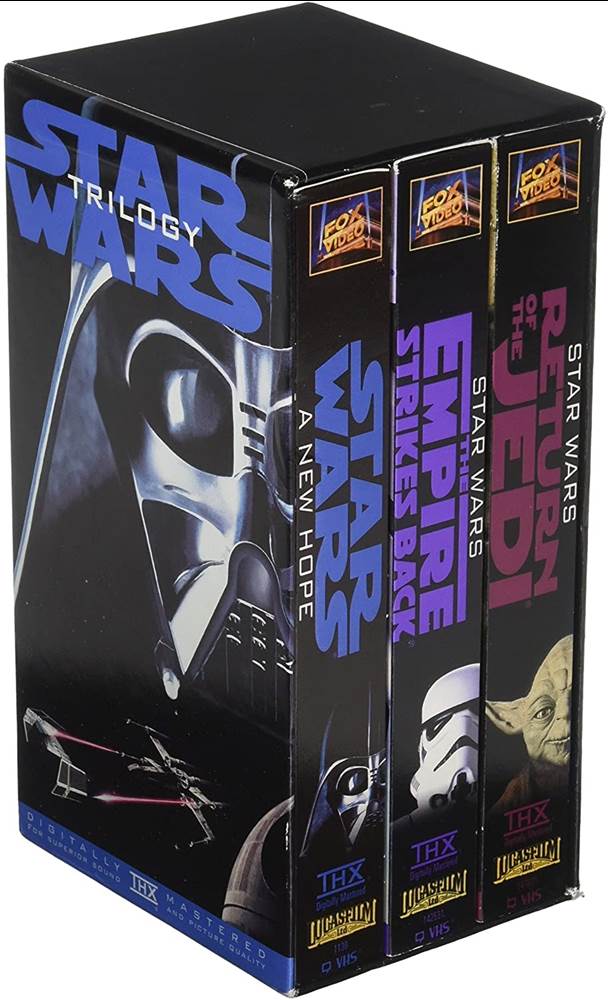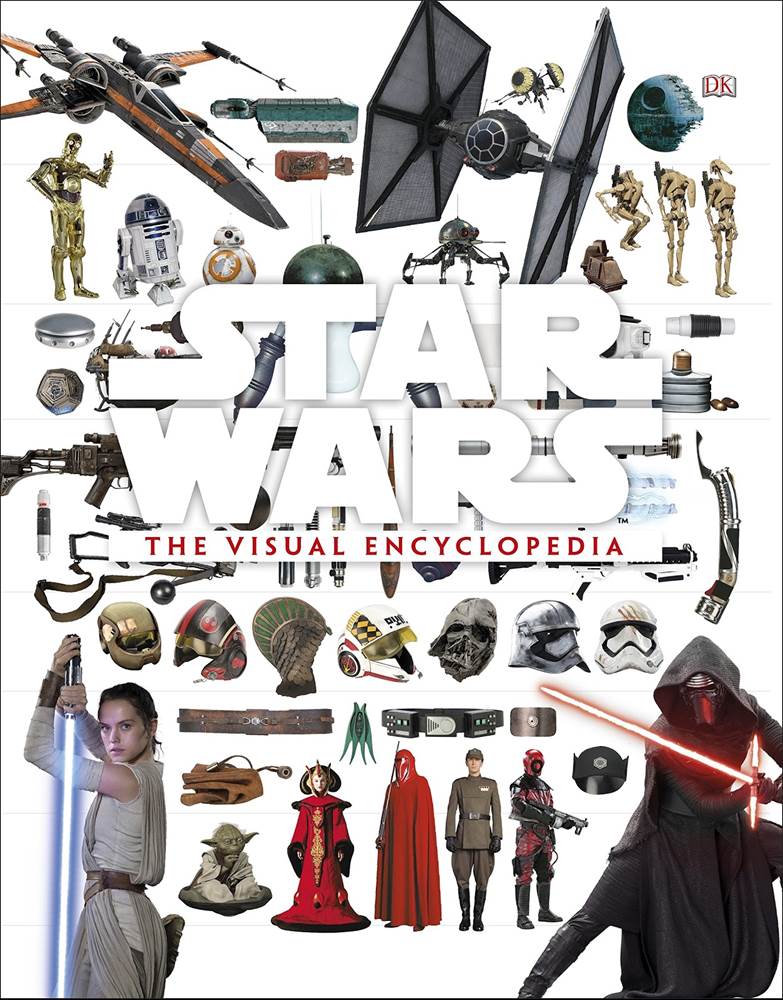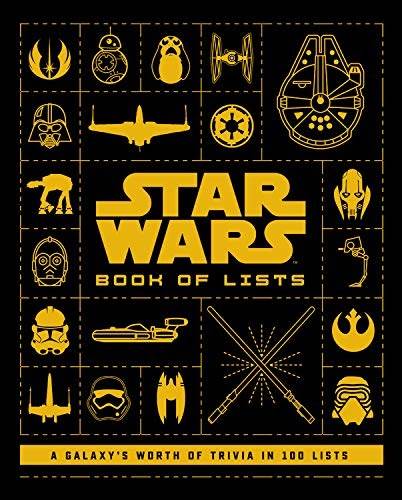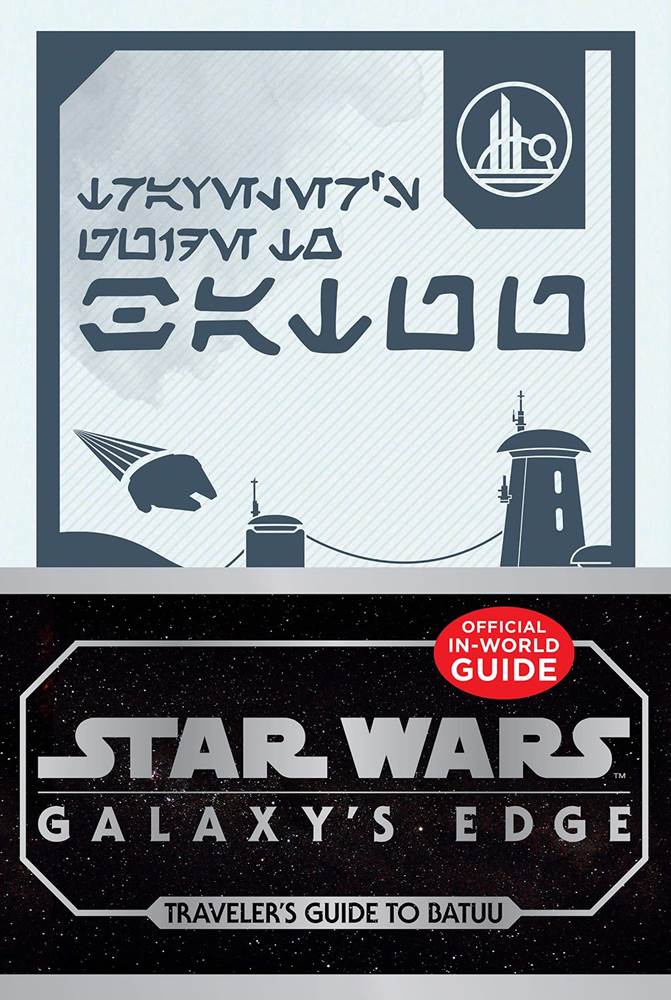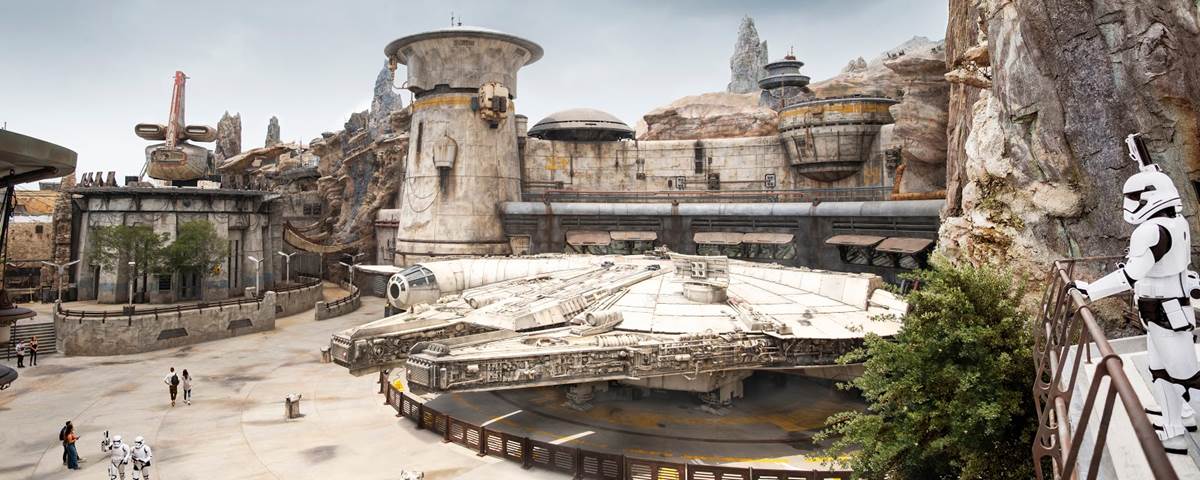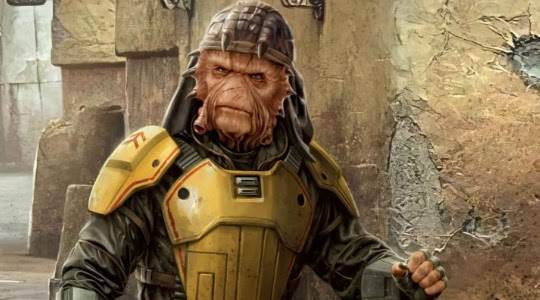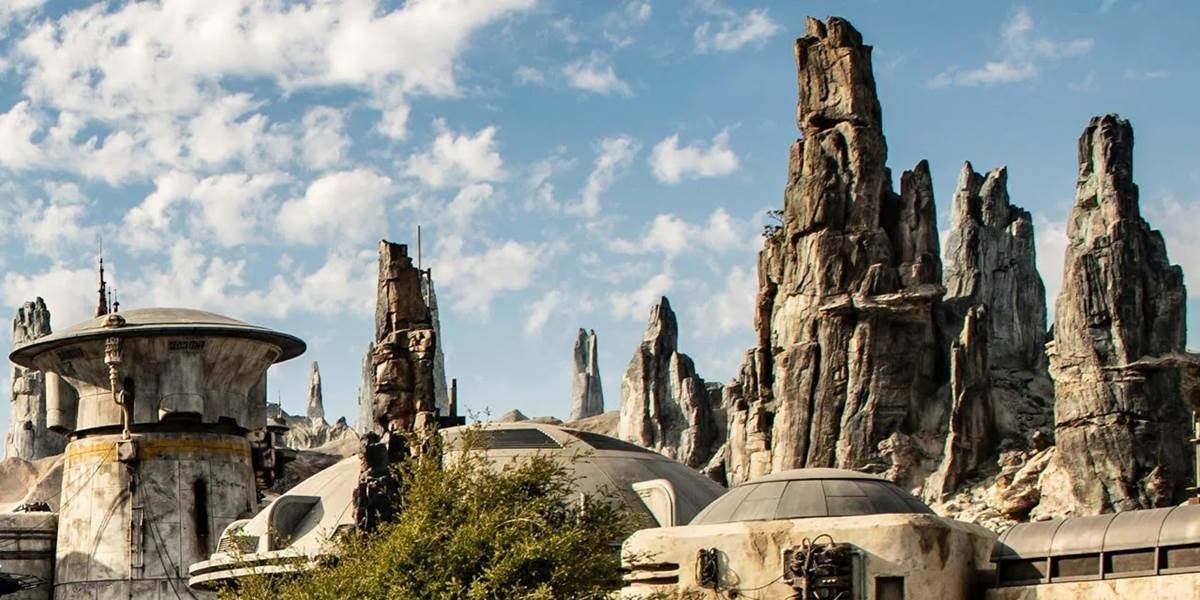Interview – Author Cole Horton Discusses “Star Wars: Galaxy’s Edge – Traveler’s Guide to Batuu” and More
Author Cole Horton has been contributing to the Star Wars universe for a number of years thanks to either writing or co-writing over a dozen reference books explaining the many intricate details of A Galaxy Far, Far Away. His two most recent books are entitled Star Wars: Book of Lists and Star Wars: Galaxy’s Edge - Traveler’s Guide to Batuu.
I recently sat down with Cole Horton via Zoom for a fascinating conversation about his writing career, his history as a Star Wars fan, and how he goes about putting together these in-depth Star Wars reference books with the help of Lucasfilm, Disney, and his publishers. You can watch the full interview in the following video or read the abridged transcript below. Enjoy!
Watch Interview: Author Cole Horton discusses "Star Wars: Galaxy's Edge - Traveler's Guide to Batuu," more:
Mike Celestino, Laughing Place: Thank you so much for joining me, Cole.
Cole Horton: Happy to be here. Thanks for having me.
LP: Let's start at the beginning. What was your relationship like with Star Wars growing up? I'm assuming you were a fan.
Horton: [sarcastically] A little bit, yeah. I discovered Star Wars by accident before the special editions had come out. Those VHS tapes from 1995 are what did it for me. And it was weird-- as a kid, you're into a lot of stuff and you kind of grow out of it, but I never grew out of Star Wars. And at age 16 I had founded my small-town Indiana Star Wars fan club. By 18, I had joined the 501st and I found myself doing Star Wars celebration conventions, and one thing led to the next and before you know it I was writing for StarWars.com, and then eventually writing books. And through a weird kind of coincidence at my day job, I've even intercepted Star Wars. I've worked on games at EA for five years as well. So yeah, I'd say for the past five years, up until just recently, it was 200% Star Wars all day, all the time.
LP: That's awesome. So those VHS tapes, those were the ones with the half faces, like Yoda's face and then the Stormtrooper, right?
Horton: That's right, and I didn't know any better and I bought them out of order. So I bought the one with Darth Vader on it because that looked cool. And then I bought the one with Yoda on it, or the Stormtrooper, whichever one it was. But I saw Return of the Jedi before I saw The Empire Strikes Back. And you know what? It didn't seem to hurt my fandom at all. There's no right way to be a Star Wars fan.
LP: I agree, and I feel like a lot of that information was out there anyway in the cultural zeitgeist. You probably already absorbed that Darth Vader was Luke Skywalker's father. But what about Disney Parks? Did you spend a lot of time there growing up?
Horton: Growing up, we were that family that did that once-in-a-lifetime vacation when I was younger. But my wife actually would go almost annually with her family. We got married shortly after college and started making trips somewhat frequently. Star Wars Weekends, of course, were a big driver for me. Somehow coincidentally, our trips always tended to end up there so we could do Star Wars Weekends. And over time, we've [become] annual passholders on both coasts of the domestic parks. We've lived in California, we've lived in the Midwest, and now we're in Florida, so we've always been in and around various parks. In the past few years, it became really what all of our free time was-- doing Disney stuff. We're DVC members, annual passholders, Disney visa… we do all that stuff.
LP: Let's talk about your writing career. How did you first get into that field?
Horton: Maybe by accident. I was a history student and a historian by trade, doing a lot of research and stuff. And I had started writing a series that I thought could be a book called From World War to Star Wars. It was all the parallels and connections between Star Wars and World War II. I was in the process of making some inroads with people and pitching that when the sale of Lucasfilm to Disney occurred, and that was this interesting reset period in a lot of ways. I had all of this content-- I had a 60,000 word outline for what I had hoped would be a book. That's crazy talk-- I didn't know any better. That's not really how it's done, but that's what I had. And I pitched that to StarWars.com, and thankfully Matt Martin at the time was working there and gave me a chance, and let me do monthly articles about that topic and put that content out into the world.
I did that for a few years when the flood gates opened. There had been all this secrecy and quiet as everyone was just trying to figure out what the next trilogy was going to be, and all of a sudden, they needed authors. And because I was writing on StarWars.com, I had separately met a number of people in the publishing world. My name got called and I somehow got my foot in the door. And then once I did that, they kept asking me back [for] 13 books, I think it is.
LP: Let's go through a few of those books. If you could just tell me what each of these are about, for people who don't own them already, if they wanted to go pick them up. Let's start with Star Wars: Absolutely Everything You Need to Know. What's that one?
Horton: That one is really dense-- more for younger audiences-- reference book that's just going to tell you everything you need to know, whether you have some familiarity or no familiarity with Star Wars. That series kicked off in the lead up to The Force Awakens as part of the “Journey to” program. And it really was there for younger readers or parents with children to learn all of the need-to-know facts, but also a lot of the more fun facts.
LP: Star Wars: The Visual Encyclopedia. They've put out a bunch of these, one for each individual film. This one, I'm assuming, covers the more broad franchise as a whole. Is that right?
Horton: Yeah. All of these books so far have been from DK Publishing, and they're known for their visual dictionaries that come out with each film. Growing up, I was a big fan of the original Visual Dictionary. What The Visual Encyclopedia is, is a way of taking everything from that universe-- still very visual, as is in the name-- but recataloging it and pulling [in] some of the stuff that we might've missed or [might] not have been included before, and catalog it as if it was a real encyclopedia-- as if all of this stuff was real and existed. So there are spreads after spreads about all the different blasters, or all the different lightsabers, across the entire storytelling that existed at that time. But there's also a spread in there about luggage and art, and just everything. If you just looked at one movie, there might not be a ton of luggage. But funny enough, as you catalog all these films, there's actually quite a bit-- there's more luggage than you would think. So we get to shine a little bit of a spotlight on some of the more obscure stuff as well.
LP: Ultimate Star Wars: New Edition. Now this was a book that had come out previously and you updated it?
Horton: I was one of the people updating it. Adam Bray did so much of the heavy lifting on that and then I came in as well. Ultimate Star Wars was that ultimate reference book. It was capturing the storytelling that existed at that time. And then over the years, of course, we added a lot. We added multiple films from various eras, more Clone Wars storytelling had come out, Star Wars Rebels and Resistance and things like that didn't even exist, video games… it was our chance to go back and update that. On something like that, it's hard knowing you have to make decisions about what to include, and you want to make it ultimate, so you're trying to cram in as much as you possibly can-- its’ a very dense book. It’s crazy how much is in there.
LP: Star Wars: Book of Lists is a book of a hundred lists of trivia in different categories from across all of Star Wars. Where did this idea come from?
Horton: Well, like most of the ideas, not from me. Usually by the time I get contacted about [the books], there's already a seed of an idea there. In the case of Book of Lists, I think there had actually been a Star Trek: Book of Lists already from the same publisher group. That worked and of course, Star Wars just lends itself to something similar. There's so much depth there. Book of Lists is meant to be really fun. Some of these reference books are super dense and they take themselves very seriously. And Book of Lists isn't necessarily that. It is meant to welcome a wider audience of people. It's meant to sit on the coffee table and be a little bit of a hit of trivia. It's not really meant to be read cover to cover, although I'm sure there are some readers out there who will do that.
It's meant to be a quick hit and maybe for people who are less familiar with the franchise, but we also made sure there's some stuff in there for even the most hardcore fans. So it covers everything from what you need to know about Luke Skywalker and his most heroic moments, or my favorite thing that I pitched, and I thought they would tell me no, but no one did, was all the characters that Warwick Davis has played over the years in Star Wars. Those names all begin with W. That's a deep cut. It's nice to be able to have all of that in one book.
LP: What are some of your other favorite lists from the book?
Horton: I was very happy with how the “Scrolls” list turned out. All the Star Wars films have that opening scroll that goes by-- at least the Saga films. And you never really get to see them in one place, because you see one and watch a whole movie, and then have to go to the next movie to see [the next scroll]. So lining them all up in one place was pretty satisfying because you can start to see, ‘What are the similarities and differences?’, and even just the formatting things that hold them together.
I [also] love the “Wilhelm Screams” list. For anyone who's not familiar, there's this stock sound effect that sound designer Ben Burtt was a big fan of, and it's this scream from an old Western character who took an arrow and fell off a horse. Once you hear it, you know it, and it got used across a number of the Star Wars films over the years. We were able to go through and lay out all the places where that scream got used. These are just totally whimsical, weird things that normally wouldn't get the spotlight.
LP: How do you do research for books like this? I know you know a lot about Star Wars, but are you getting the bulk of this information from what's already inside your own head? Are you surfing Wookieepedia a lot? Or is there a database that Lucasfilm gives you to access with that kind of information?
Horton: Especially for Book of Lists, it was shockingly in my own head. At least the list and all the bullets on each list were written in a journal while I watched TV. Most of it was in my head. Then there's a feedback process as well. I put together the manuscript, I send that off to my editors at becker&mayer!, and then that goes to the editorial team at Lucasfilm, which then gets a pass through the Lucasfilm Story Group-- the people who keep all the continuity together. By the time it comes back to me, there's lots of notes.
It was actually great, because I could get the bulk of each list pretty much set out. But if I missed anything, or especially-- because we wrote this more than a year ago now-- if anything was for The Rise of Skywalker, anything that was super secret, I could get little hints. [I’d] get back notes to know at a minimum [to] leave some space. As the process goes on, we're going to need to add those in there. And that's fun, to feel like you know something about a super secret film that's coming out over the holidays; that's always good.
LP: Let's get into Star Wars: Galaxy's Edge - A Traveler's Guide to Batuu. You mentioned that Book of Lists had been written for about a year. Was Traveler's Guide to Batuu something that you would have started writing that long ago as well, or was this written more recently since the land has opened?
Horton: I think I wrote Traveler's Guide before Book of Lists. I wrote Traveler's Guide right around Star Wars Celebration in Chicago, which would have been April of last year. And no, the land wasn't open, so I had to put myself in the mindset of some expert who's been there dozens of times, and it didn't exist. I think at that point the different coasts were in different places [construction-wise] and a lot of the concrete was still wet. Much like the other authors who were working on a lot of other projects that tie in to Galaxy's Edge, I was provided this creative guide-- this incredibly dense and incredibly long document that had tons of art and all the descriptions, and all of it had come out of that collaboration between Walt Disney Imagineering and Lucasfilm. I was working off of that.
The bulk of it was written before I got to go. I did get to visit Disneyland during that initial month, that preview period. I was terrified, because what if I had it wrong? They had us all queued up out there, marching us in, and I'm just turning every corner like, ‘Did I do it?’ But luckily the resources were amazing, including, the giant model that they had of Galaxy's Edge at D23 Expo [2017]. I was actually given photography of that model-- they were able to take it apart and provide me ground-level images. So it was almost like someone had been into this place already and taken pictures from where you would be, and I was able to get a sense for the space. I knew I had to take people on a logical path. I had to figure that out logistically, and then know what came next and describe it that way.
I wrote it much like Rick Steves would write a travel guide. I wanted to write it that way, but there's always this logical path. And I was always afraid that I would get something out of order, like, ‘Where's the milk stand? And where is that in relation to where the First Order has set up?’ And doing that all on paper was a challenge. The good news is the lands are more similar than they are different, especially in terms of the structures, so there [weren’t] even really challenges there. It was great because I had, again, all the help and oversight from Imagineering and Lucasfilm. I got it largely right.
LP: So since the land has opened, how much time have you spent there?
Horton: I went once, because I was up in San Francisco that whole time. We came down for that preview. I have not gotten to experience Rise of the Resistance yet. But funny enough, I am largely spoiler free on all of that. One of the things that we wanted to do in this book is, it's in-universe. It's written as if somebody is there and writing this guide, and they have a point of view and they know things and don't know [other] things. We really wanted to make sure that the ‘author’ of this didn't know and couldn't spoil some of the things that guests really just needed to experience for themselves. So we're going to talk a lot about the docking bays, and we're going to talk about the Millennium Falcon, but we're not going to talk about what happens on Smugglers Run. That is for you to go experience, just like we're going to hint at what's going on in the outskirts and how there is this maybe Resistance activity, and there's hushed rumors of stuff going on out there. ‘Oh, aren't those caverns very mysterious and maybe dangerous?’
We're not going to take you on Rise of the Resistance and spoil everything you see in there. Nor is this book meant to sell you merchandise. The catalog of merchandise isn’t in there. We talk about droids, but we don't talk about [the droid-building] experience exactly. And we talk about some of the more mystical elements that are going on on Batuu, without spoiling what happens if you were to go inside Savi's Workshop.
LP: There are hints in the book to things that we haven't yet experienced in Galaxy's Edge. One of those things is the bounty hunter Harkos, who was revealed previously in concept art, though hasn't shown up at the land yet. You also talk about the local holidays on Batuu: one's called Black Spire day, which is of course held on May the 4th. You also mention Life Day. Do you think that these are things that we might eventually see in Galaxy's Edge?
I don't work on Galaxy's Edge day to day, nor can I speculate about the future. But I think if anything was truly off the table, I don't know that it would have been included [in Traveler’s Guide].
LP: That makes sense to me, especially considering this book is coming out over a year after the land has opened. Now for a location like Dok-Ondar's Den of Antiquities, obviously there are hundreds of Easter Eggs and little references hidden all over the place. I'm sure you've got a list of what those were, but how did you decide which to include and which not to include?
Horton: It's a bit of [considering] what is important and what adds variety. You're trying to strike that balance. And you're actually trying to do that throughout the whole book-- because you could, in theory, get really deep into [for example] how the queues work and things like that, but that's not really interesting. With something like Dok's, you're trying to pick stuff that is need-to-know, or maybe a lot of people might not quite know, and you want to make sure they have that information, versus just what seemed cool. Actually on Dok's, I actually went way too deep. I had a whole crazy history for what we know as the Ark of the Covenant that was hidden there. That one was actually [removed from the book] just because sometimes an Easter Egg needs to be an Easter Egg. You need to leave some surprises for people there. But I had talked all about its in-universe connection and how it had been seen on Ryloth and its value to the Twi'lek people and its role in the Clone Wars and all sorts of stuff. We yanked that out.
LP: I wonder if the removal of the Ark of the Covenant from your book is related to the removal of the Ark of the Covenant from Galaxy's Edge, because it's since been taken out of the land.
Horton: I actually think it's not related at all, because this was even before it had likely been placed. At the time it was just like, ‘Hey, let an Easter Egg be an Easter Egg.’ Where it's gone now is a complete mystery to me.
LP: You mentioned earlier that your in-universe persona is the author of this book, and the name of that character is a clever anagramization of your actual name, in the Star Wars tradition. How does it feel to have that version of yourself now exist within the Star Wars canon?
Horton: It's pretty cool. That's one of the things I put in there and [didn’t] know if they were going to change it. Like, is it a little bit too on-the-nose? I'm Cole Horton. The author of this book is Eloc Throno. It's just my first name spelled backwards. It's kind of obvious. And they let it ride. They let it go through. Star Wars Galaxies might be my favorite video game ever, and my character name in Star Wars Galaxies all those years ago was Eloc. It's neat to be able to pull that forward and keep that little bit of my fandom going.
LP: What ended up being your favorite thing about experiencing Star Wars: Galaxy’s Edge and writing about Star Wars: Galaxy’s Edge?
I had all this background information and schematics and everything, and then I got there and it was still cooler. It hadn't been spoiled at all. In fact, I think I had underestimated how great it was going to be in scale and detail and just how I [felt] when I was there.
So much of this book is just what I liked to read as a kid. I liked blueprints, so blueprints are in there. I liked the roleplaying guides from back in the day-- not because I was playing tabletop roleplaying games as a 12-year-old, but because they would just give you a list of cool gear. I want a list of cool gear, because there's going to be families sitting around planning their trip. They're going to have this guide, and they're going to want to know who they are in this universe. The whole guide was written with that in mind, so you can piece that together. I've been hearing a lot of people are excited about the maps. It was fun to get to create some backstory and history for nearby planets. I got to make it up. I thought, ‘You know what we need? A nearby beach planet.’ Because if you want to go have a beach day in the Star Wars universe, we need a nearby beach planet. So I got to invent a planet [with] all these white sand beaches. But again, it all came back to families planning vacations.
LP: That's definitely how I thought of the book as well. I think it'll be a great guide for people planning their trips.
Horton: That's the sort of stuff that made this a dream job. I'm not sure how I top this. As a Disney fan, as a parks fan, as a Star Wars fan and professional, this is better than I could have ever imagined. In 2015, I don't think we could have imagined something like this would even exist.
LP: That's true, but you may top it eventually because you also have more Star Wars books coming out. Later this year, you have The Star Wars Book: Expand Your Knowledge of a Galaxy Far, Far Away. And this is co-written with Pablo Hidalgo and Dan Zehr, is that correct?
Horton: That's right, yeah. Pablo [and] Dan [are] guys I've known for years [but] had never got to work with them. The Star Wars Book is a totally different format than everything else I've worked on-- more of [an] essay style, and really going deep on all the key topics and picking apart some really interesting themes or things you might not think about, finding some threads that are common across a character’s story or events-- just a really neat way to look at the galaxy. That'll be out this fall. I'm excited to see that book when it comes out. This is a team effort. There's so many people behind the scenes. It's really unfair that I get to put my name on it because I only did one part. And it's always fun.
LP: Thank you so much for taking out some time to chat with me.
Horton: Anytime. I'm glad to be here.
LP: I hope to run into you someday on Batuu.
Horton: Till the Spire!
Star Wars: Book of Lists and Star Wars: Traveler’s Guide to Batuu are available now wherever books are sold. The full audio version of this interview is available as part of Laughing Place’s “Who’s the Bossk?” Star Wars podcast.




